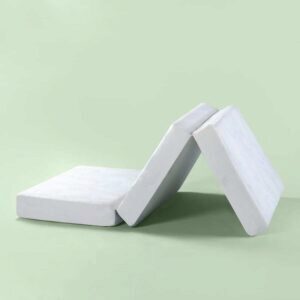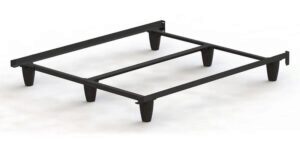High vs. Low Beds: How to Pick the Right Bed Height
Disclosure: By clicking on the product links in this article, Mattress Nerd may receive a commission fee at no cost to you, the reader. Read full disclosure statement.
When you’re shopping for a mattress, it’s easy to get distracted by details like how soft it feels or whether it sleeps cool. But bed height is another important consideration. Don’t confuse it for mattress height. Bed height is the distance from the top of the mattress to the floor and includes the mattress plus accessories like the bed frame and box spring. As you weigh your options, here’s how high and low beds compare, plus our tips for picking the right bed height.
Bottom Line: How Do You Pick the Right Bed Height?
Ideal bed height varies depending on an individual’s height and age. In general, an appropriate bed height can be measured by sitting on the side of the bed. If your knees aren’t close to 90 degrees with your feet on the floor, it’s likely too tall or too short. According to most mattress companies, around 25 inches is the average bed height.
Video Comparison

Factors That Affect Bed Height
Keep in mind that there are no rules about the best bed height. The most appropriate height hinges on personal preference. Maybe you like the idea of a tall bed that you have to climb into at night, or you love the modern appeal of a low platform bed. That’s perfectly fine! But if you’re looking for recommendations to guide you toward a bed height that should accommodate you comfortably, here’s what to keep in mind as you shop.
Your Height
Factoring for your own height is important. If you’re tall, you may want to opt for a higher bed height so you don’t feel like you have to bend over to climb into bed (or pull yourself upright when you get out!). You can increase bed height by looking for taller mattress heights, opting for full-size box springs, or getting a tall bed frame.
Those on the shorter side may want to look for a mattress with a lower profile, as well as a lower bed frame and a slimmer box spring.
Your Age
Bed height may be a bigger issue during certain life stages. Children, for example, may benefit from lower bed heights, which makes it easier to get in and out of bed and poses less of an issue in the event they roll out during the night.
As you age, mobility issues may become a concern. In that case, an appropriate bed height can minimize challenges posed by beds that are too low or too tall.
Mattress Height
The height of your mattress itself will affect overall bed height. Mattress height can vary, typically ranging between 8 and 14 inches, but some are even taller—up to 17 inches. As you consider bed height, remember to check both your frame height and the height of the box spring or foundation.
Box Spring/Foundation and Bed Frame
Foundation supports like box springs add height as well. If you have a taller mattress and bed frame, for example, you may want to consider a low-profile box spring. Most box springs are around nine inches in height, with low-profile options around five inches.
Common Bed Heights
- Platform bed: These frames are typically low to the ground and feature horizontal wooden slats for mattress support. It has a modern aesthetic, but the lack of space beneath the bed means little to no storage space.
- Traditional bed: Traditional beds are generally about two feet off the ground, though that measurement varies. They’re usually designed for use with box springs, which add additional height, and have a traditional aesthetic.
- Adjustable base: Adjustable bases can be moved into different positions to include the head and sometimes the foot of the mattress. Some come with extra upgrades, like USB ports, under-bed lighting, and massage modes. Heights vary depending on the manufacturer and model. Because you can adjust the positioning of the bed, adjustable bases can be a great pick for those who may have mobility issues.
- Upholstered bed: If your bed frame is covered in fabric, it’s considered upholstered. Again, heights may vary, but generally upholstered frames tend to be a little lower to the ground. If you like the look but prefer more height, you can opt for a taller mattress and foundation layer.
Who Should Choose a Low Bed?
Low beds may be a better choice for people who are on the shorter side. They can also be a good choice for children. Seniors or people who have mobility issues may find that short beds sound like a good option, but the reality isn’t ideal. Keep in mind that going from a seated to a standing position on a shorter bed requires pushing yourself upright, and that might be challenging.
Who Should Choose a High Bed?
High beds can be a good pick for taller people since the height makes it easier to get in and out of bed. If you’re looking to add height to an existing bed, remember that box springs can vary between five and nine inches.
Frequently Asked Questions
Is it easier to get out of a high bed or low bed?
It depends on your height and stage of life. Lower beds require you to push yourself upright, which may be difficult if you’re a senior or navigating mobility limitations. Taller people will likely find it easier to get out of a taller bed.
Is a low or high bed better for a small room?
Scale and proportion are important considerations in smaller rooms. Oversized furniture in a small space can make it feel cramped. A low bed, which takes up less vertical space, can make a small room feel bigger.
Takeaway
While there are no hard and fast rules about the best bed height. A bed that’s too tall or too low can be an inconvenience every morning and every night. A bed is generally considered appropriate in height when you can sit on the edge with your feet on the floor and your knees close to 90 degrees. Remember that your own height and age, your mattress height, and your foundation and bed frame will all affect bed height. So will the most important factor—personal preference.


